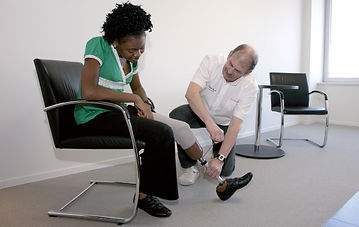BIOTECHNOLOGY INNOVATIONS

Many parts of the prosthetic like the foot and pylon are manufactured in factories, sent to the prosthetist, and assembled at the prosthetist facility to fit the patient's needs. Whereas some parts, like the socket, are custom-made. Sometimes, facilities actually have services where every part of the prosthetic is custom-made from start to finish.
DEVELOPERS -
USERS -
Users and patients of these prosthetic limbs are people, or even animals in some cases, that have lost their lower limbs due to trauma, disease, or congenital conditions. Many changes are made to prosthetics to fit the patient’s unique features and/or make it more comfortable for the patient to live with the prosthetic depending on the type of condition they’re in.
After the prosthetic is fitted, patients are trained to become comfortable with using the prosthetic on a daily basis, whilst doing daily activities. It takes 18-10 weeks for a new amputee to walk again. Many different exercise techniques are incorporated to strengthen muscles involved in moving the artificial limb. New amputees are taught to wash the devices daily, and how to get them on and off.


The prosthetist evaluates the limb, measures the lengths of body segments, and determines the location of bones and tendons in the remaining part. Then a prosthetic technician makes a plaster cast of the stump, then a positive model is created by taking a sheet of clear thermoplastic, heating it in a large oven and then forming it around the positive mold. The air is sucked out, forcing the sheet into the exact shape of the mold. This is the test socket, used to check the fit. Before the permanent polypropylene socket is made, the prosthetist works with the patient so that the test socket fits and is comfortable for the patient. Then the various components of the custom-made limb are put together, using bolts, adhesives, and laminating. The prosthetist then fits the permanent socket, which is attached to the patient, with the completed limb.
After the prosthetic is fitted, patients are trained to become comfortable with using the prosthetic on a daily basis, whilst doing daily activities. It takes 18-10 weeks for a new amputee to walk again. Many different exercise techniques are incorporated to strengthen muscles involved in moving the artificial limb. New amputees are taught to wash the devices daily, and how to get them on and off.
The most advanced and expensive prostheses are myoelectric. They use electrodes to sense muscular impulses in the residual limb and electronic control systems detect those signals and amplify them to power electric motors that operate the prosthetic limb as though it were real. These are electrically controlled and powered by rechargeable battery packs.